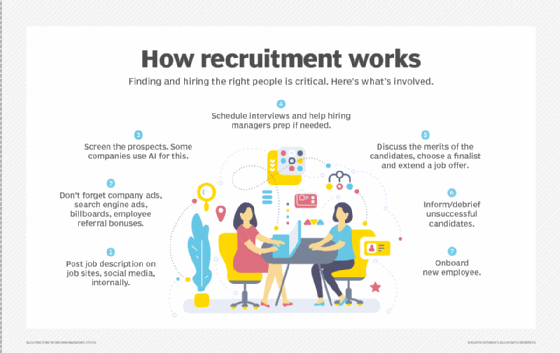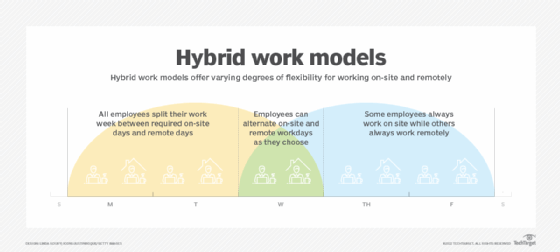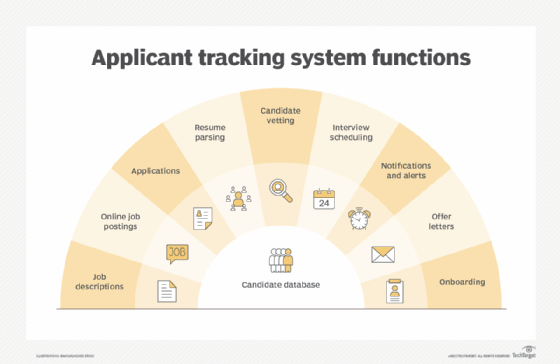Ultimate guide to recruitment and talent acquisition
It's no longer good enough to recruit for today. You need to take a long view and build a workforce for the next stage of growth. Here's how talent acquisition helps.
Recruiting workers is as old as commerce itself. As a matter of survival, businesses have always had ways to identify and attract workers, decide if they're suitable, agree on pay, then hire and integrate them into the company.
Rapid advancements in technology, coupled with the disruptive force of a global pandemic, however, have brought fundamental change to this age-old discipline. Today, recruitment is not only mostly computerized, but -- thanks to the COVID-19-induced shift to remote work -- the talent pool spans the globe. AI tools enable companies to measure applicant qualifications in the blink of an eye.
At the same time, finding workers with the requisite skills to handle these volatile times -- and knowing what skills will be needed to ensure business success in the future -- has become more challenging than perhaps ever before. To meet the challenge, many companies have made recruitment part of a broader talent acquisition strategy that looks beyond short-term needs and ties hiring to long-term business objectives.
This comprehensive guide provides an overview of recruitment and talent acquisition, explaining their differences and similarities. You'll also find a breakdown of each process, explanations of key methods, best practices and technologies, instructions for developing a talent acquisition plan and a glimpse of where recruiting may be headed in the future. Throughout the guide are links that take you to articles that provide a deeper dive into the essential concepts and trends.
What is recruitment?
In recent years, the term recruiting has been subsumed by the fancier-sounding talent acquisition, and though the terms are sometimes used synonymously, there are important differences.
Recruitment is the process of finding, screening, hiring and eventually onboarding job candidates. It is the biggest component of talent acquisition but has a more near-term focus on the practical steps of the hiring process, while talent acquisition looks more to the future and the skills and talent that organizations will need to remain competitive.
The recruiting process usually begins with a job requisition: a formal request to create a new position -- or fill an existing one -- that justifies the need for the position and provides key details, such as the timing of the hire and whether the position is full or part time.
If the requisition is approved, the hiring manager -- often in collaboration with the HR department -- writes a detailed job description that amplifies and tailors the information provided in the requisition.
The job description is the basis for the job listing that will be posted internally on the organization's career page and externally on job boards or through social media. The job listing has additional language that explains the career opportunities of the position. For an external posting, the job listing not only provides an accurate and compelling explanation of the open position but also sells the organization and possible reasons for wanting to work there.

When people apply for a listed job, their résumés and applications are then screened, often automatically by applicant tracking system (ATS) software. Interviews and other screening methods, such as pre-hire personality tests and employment background checks, are used to learn more about candidates and assess their suitability for the role.
After the hiring managers review the information on each qualified candidate and decide on a finalist, negotiations with the chosen candidate about salary, vacation time and the like ensue, and a formal offer is drawn up and delivered. If the candidate accepts and signs the offer, the onboarding process begins, typically before their first day on the job.
What is talent acquisition?
The standard recruiting steps outlined above are the daily nuts and bolts of talent acquisition. But here's where talent acquisition differs from recruiting: Talent acquisition goes beyond basic hiring by adding strategic elements that apply detailed analysis to the organization's overall talent needs, how those needs relate to business goals and what HR and recruiting specialists can do to close the gaps between the two.
It's also important to note that talent acquisition is not the same as the similar-sounding talent management.
Talent acquisition focuses mainly on recruiting and onboarding, which are the first major steps of the even broader field of talent management. The latter is the comprehensive process that continues through the entire employee "lifecycle" and includes learning and development, performance management, compensation management and succession planning.
Therefore, while talent acquisition draws upon some of the data and analysis of these later stages of an employee's tenure -- for example, by analyzing the performance reviews of successful employees to see what characteristics to look for in a job candidate -- it primarily maintains a focus on recruitment.
Process model
While the differences between recruitment and talent acquisition described above may seem clear, in practice, HR professionals, consultants and vendors of HR software often disagree on exactly where to draw the line between talent acquisition and recruiting. The two disciplines overlap more than they diverge, and the reality is that the bulk of talent acquisition work often gets done in an organization's existing recruitment process.
To clear up the confusion, let's break down in more detail how talent acquisition goes beyond recruiting:
- Lead generation and sourcing. Talent acquisition adds one very important step to the beginning of the recruitment process: lead generation and sourcing. Talent acquisition specialists actively investigate and manage the best sources of prospective candidates who meet the organization's needs, then gather leads (such as names and contact information) for individual candidates. Talent acquisition specialists spend far more time than recruiters do on identifying and investing in sources that can feed the talent pool and on making sure it remains well stocked.
- Continuous improvement. Once the recruitment process begins, talent acquisition continues to serve as both an overlay to recruitment and as an external process for judging its effectiveness and identifying ways to improve it.
- Analytics. Data analytics is the primary tool used in talent acquisition to measure and improve an organization's talent and recruiting strategy. It can, for example, identify the sources of the best talent in the organization, analyze the characteristics that top performers have in common and measure the effectiveness of job listings on specific social media platforms.
Methods and strategies
Recruitment marketing. Having a recruitment marketing strategy is essential in any effective talent acquisition strategy. Recruitment marketing is a subset of marketing dedicated to promoting the organization as a desirable place to work, reinforcing the employer brand and corporate culture, and building up a database of leads, many of whom will be passive candidates not actively looking for work. Current employees play a key role in marketing the company through employee referrals, video testimonials and social media.
Source of hire. Another effective talent acquisition strategy is to have a process for identifying the source of hire (SoH) of top-performing employees -- sources such as the company's career site, employee referrals and job boards. An ATS can track SoH information and slice it into useful categories, such as passive candidates, unsuccessful applicants or geographic regions. Analytics software can glean further insights from this data.
Social media recruiting strategies. Social media sites are often a key component of recruitment marketing, but they also have a distinct role in talent acquisition that goes beyond simply marketing the employer brand. Social media platforms -- especially LinkedIn and niche sites like the software development site GitHub -- also function as two-way communication channels for posting jobs and interacting with candidates in the early stages of recruiting. For this reason, social media recruiting is now a standard part of talent acquisition.
Challenges: COVID-19 pandemic reorders talent acquisition and recruitment
Recruiting and talent acquisition were challenging enough before the COVID-19 pandemic struck in the first quarter of 2020. The "war for talent" was in full force, as many Western countries' economies neared full employment and companies struggled to fill open positions.
As the pandemic disrupted the workforce, companies radically rearranged hiring priorities and scrambled to understand a new set of challenges, but the need for a solid talent acquisition process did not go away.
Many companies quickly realized they needed to figure out how to hire remote employees and how the boom in remote work was changing corporate cultures, productivity and talent management. Other businesses that require most of their work to be performed on site, such as retailers, restaurants and logistics providers, have faced labor shortages that threaten their ability to stay in business. For these companies, recruiting and employee retention have only gotten harder.
Most organizations have had to deal with these new talent acquisition challenges while learning how to conduct more of their recruiting processes virtually than ever before. The biggest change is remote onboarding. An essential process that used to happen mostly in person and via email and phone must now be conducted almost entirely online, especially for new hires who will only work remotely. It brings unprecedented challenges, such as how to transmit the corporate culture and help remote workers make friends, collaborate effectively and feel like part of the team. Organizations are having to quickly adopt remote onboarding best practices to ensure a quality onboarding experience, which is known to be a major contributor to employee satisfaction and retention.
As the pandemic wanes and pressure mounts to return to the office, many organizations are adopting a hybrid work model that allows some employees to work remotely at least some of the time. Polling the needs and preferences of employees and managers, coming up with the best mix of on-site and remote workdays, identifying which jobs are best suited to each, and planning the necessary technology upgrades have required significant thought and discussion. A formal policy is often the end product. To carry out their new policies, organizations must navigate a new set of challenges and are seeking out hybrid work model best practices.

Benefits of effective recruitment and talent acquisition
Identifying the skills and people an organization needs to deliver on its mission and strategic goals, then hiring the best candidates to meet the identified needs, are essential to the organization's very survival, let alone its ability to grow.
Effective talent acquisition has numerous other benefits, including the following:
- improved employee experience and engagement;
- higher productivity;
- improved employee retention (and, therefore, lower turnover), which, in turn, reduces the cost to hire and train new employees;
- more innovation in products and services, thanks to the creativity of experienced and highly skilled employees; and
- higher revenue from improved productivity and innovation.
How to develop a plan
Taking a strategic approach to recruiting requires a willingness to step back and examine what is working and what isn't. It also requires that companies not neglect broader goals in the rush to fill immediate needs. This big-picture perspective is exactly what talent acquisition brings to the process of developing a recruiting strategy.
When building a recruiting and talent acquisition plan, consider taking these steps:
- Assess current organizational strategies. The overall business plan, departmental plans and workforce plan are good sources of the top-level considerations that should guide the recruiting plan. These might include new lines of business, mergers and acquisitions, and global expansion.
- Research best practices. Templates and other guides to effective recruitment and talent management are widely available, often for free, online.
- Solicit stakeholder feedback. Departmental managers, HR and senior executives will expect to have input into the overall talent plan. They're also the best source of experience and insight into business processes.
- Define the employer brand. First, conduct a study to identify public perceptions of the brand, either formally or by checking sites such as Glassdoor. If the brand image isn't aligned with business goals, take steps to fix one or both, then incorporate them into recruitment marketing and other communications.
Products and tools
Organizations can choose from a wide variety of recruiting and talent acquisition software.
A human resource management system (HRMS), or core HR system for managing employee records, payroll and benefits, is usually the first HR technology installed at an organization. It may come with a basic recruiting module, but most organizations find they quickly outgrow it. That's why it's important to look for specialized recruiting software.
After the HRMS, perhaps the most commonly used HR technology is the talent management software suites from vendors such as Cornerstone OnDemand, Oracle, SAP SuccessFactors and UKG. These suites handle all of the major phases of talent management, starting with recruiting, continuing through performance management and ending with offboarding, the mirror image of onboarding, which is completed when employees leave the company. Most of these suites are delivered as SaaS, which means the software vendor is responsible for the computing infrastructure and delivers it to users over the internet.
It's not always necessary to buy a talent management suite. Many organizations run their recruitment and talent acquisition efforts entirely from their applicant tracking systems.

Other software products focus more narrowly on certain steps in the recruiting process, and some online job boards can process résumés, applications and communication with candidates. There are also SaaS talent acquisition platforms that handle more of the recruiting steps.
A recruitment management system can be one of the most effective tools for partially automating the talent acquisition process. An RMS is really more of a collection of software tools that usually includes an ATS to manage the job postings and applications. It also has candidate relationship management features for staying in contact with applicants and keeping them engaged with the recruiting process and with the organization. An RMS does more than the typical ATS to match candidate résumés automatically with the skills called for in the job description.
Video interview tools provide the platform for conducting candidate interviews remotely and have AI that can analyze people's gestures and facial expressions for clues about their fitness for a job.
Technologies
A handful of computer technologies that are transforming other areas of business, such as accounting, manufacturing and e-commerce, have also infiltrated talent acquisition to help make the process more "intelligent" and user-friendly.
The use of AI in talent acquisition is speeding up candidate sourcing by applying natural language processing (NLP) and machine learning to better understand the language in job requisitions and find close matches in résumés. AI can also comb through résumés in a fraction of the time it takes humans to do so. It can help minimize discrimination against minority groups in the hiring process by reviewing qualifications and detecting biased language in job ads. However, users, advocacy groups and government regulators have come to realize that AI can sometimes be the cause of discrimination in hiring decisions, and they're taking significant steps to combat AI hiring bias.
Chatbots, many of which use NLP to interpret the words spoken or typed by users, have done much to advance the recruitment process. Candidates can respond to job listings by texting their interest from their mobile devices, and a chatbot will walk them through the steps, communicating with them in ways that are remarkably similar to that of a human recruiter.
While some vendors embed AI throughout their talent management software, there's a fast-growing market in AI recruiting tools -- usually marketed as add-ons to ATSes -- that put the technology front and center and provide specialized functions.
Some of these products are responding to a hot trend in recruiting that values employees and job candidates for their skills, rather than the traditional measures of job titles and academic degrees.
Eightfold.ai, for example, applies AI to huge data sets to extract candidate skills, which also helps organizations with upskilling and reskilling employees. Fuel50, in contrast, turns its AI lens inward to employee skills, which helps build an internal marketplace for career development, while providing data for skills-based recruiting of external candidates.
The future of talent acquisition
Talent acquisition technology trends for the near term and beyond all point to the continued growth in using AI for recruiting. In addition, virtual reality and augmented reality are slowly infiltrating talent management -- especially learning -- and some companies are using VR in recruiting to give candidates a virtual look at their potential employer. Further out is the use of blockchain -- a record-keeping technology designed to be secure from hackers -- to more easily share résumés and employment records in the recruiting process.
But these technologies will advance in the context of three HR trends that should set the tone in the near term: diversity, equity and inclusion (DEI), the rapid growth in remote work and the increasing importance of the contingent workforce. The nature of the workforce is changing, along with the ways that work itself is conducted.
After the George Floyd murder and resurgence of the Black Lives Matter movement in 2020, many organizations took a hard look at their inclusiveness strategies and established a DEI program to give minorities an equal share in job opportunities and career advancement. Running an effective DEI program requires listening patiently to diverse voices and having the will to change the culture of the organization. A common pitfall is gathering internal data that proves bias exists, then acting too slowly to remedy it, which can be interpreted as comfort with the status quo and alienate minority employees.
Meanwhile, the contingent workforce -- independent contractors, gig workers and freelancers -- is growing. Employers like contingent workers because they usually don't get benefits, can be brought in on a temporary basis and often have skills full-time employees lack. But managing temporary workers carries unique responsibilities, including challenges in cybersecurity, effective collaboration and integration into the corporate culture. There are complex compliance issues, too, with laws that restrict a hiring company's ability to tell contractors how to do their work, as well as safeguards against laying off employees and rehiring them as contractors to get out of paying benefits. HR software vendors have responded with specialized software for finding and hiring temporary workers and managing these issues. Also, more organizations are adopting contingent workforce management best practices.
In the longer term, the future of talent acquisition will mostly be centered on recruiting the people who are the future of organizations: millennials, now mostly in their 30s and looking to move up in already-established careers, and the Gen Z group that recently entered the workforce.
Effective Gen Z recruiting will require more than just the stereotypical pandering to the habits of these digital natives, such as smartphone- and social media-friendly business and HR applications. The youngest generations that now represent the future of the workforce want to feel that their work has a greater purpose in society. They're also looking for a better work-life balance and are driving much of the push for remote and hybrid work.
Organizations whose talent acquisition and recruiting strategies don't already account for these generational shifts may already be losing the next war for talent.







